On a trip to Peru, you’re likely to come across the term “Quechua”. Dig in deeper to discover the wondrous world of the indigenous Quechua people, their history, and their traditions.
Modern Peru is a mixed-race society following the encounter between European and indigenous worlds in the early 1500s. Nearly five hundred years later, Quechuan influences are still evident in Peru and across the central Andes. Their history, music, dance, dress, language, and cuisine continue to play a large role in modern Peruvian culture.
Explore more about the Quechua people’s:
The Quechua are often described as the direct descendants of the Incas, but this characterization is too simple. The Inca Empire, large and powerful as it became, was a small ethnic group that ruled for a short span of time (1438-1534). The history of the Quechua people began many years before the Inca civilization rose to power, and continued to evolve in multi-faceted ways after the Spanish conquerors and settlers arrived in the 16th century.
Aside from the Incas, there are several other historic Quechua-speaking groups. For example, the Chanka ( Chanca ) of Ayacucho, the Cañari of Tumebamba in Ecuador, and the Qulla of Western Bolivia.
Historical demographers estimate that up to 95% of the native population of the Americas died following the arrival of the Europeans. Approximately 20 million perished , if not from warfare and conflict, then from disease and poor living conditions. It would take four centuries for the total population of Latin America (including indigenous groups, Eurasian emigrants, African slaves, and their mixed descendants) to match its pre-conquest numbers. Meanwhile, the Europeans discriminated against the indigenous survivors of the conquest. They exploited their labor, destroyed or reconfigured their communities, and repressed their native traditions.
Although Peru enjoys a positive international image, great economic inequalities still exist. Unfortunately, indigenous communities continue to bear the brunt of this poverty. With this dark history as a backdrop, the persistence of Quechua culture speaks to an extraordinary will to live.
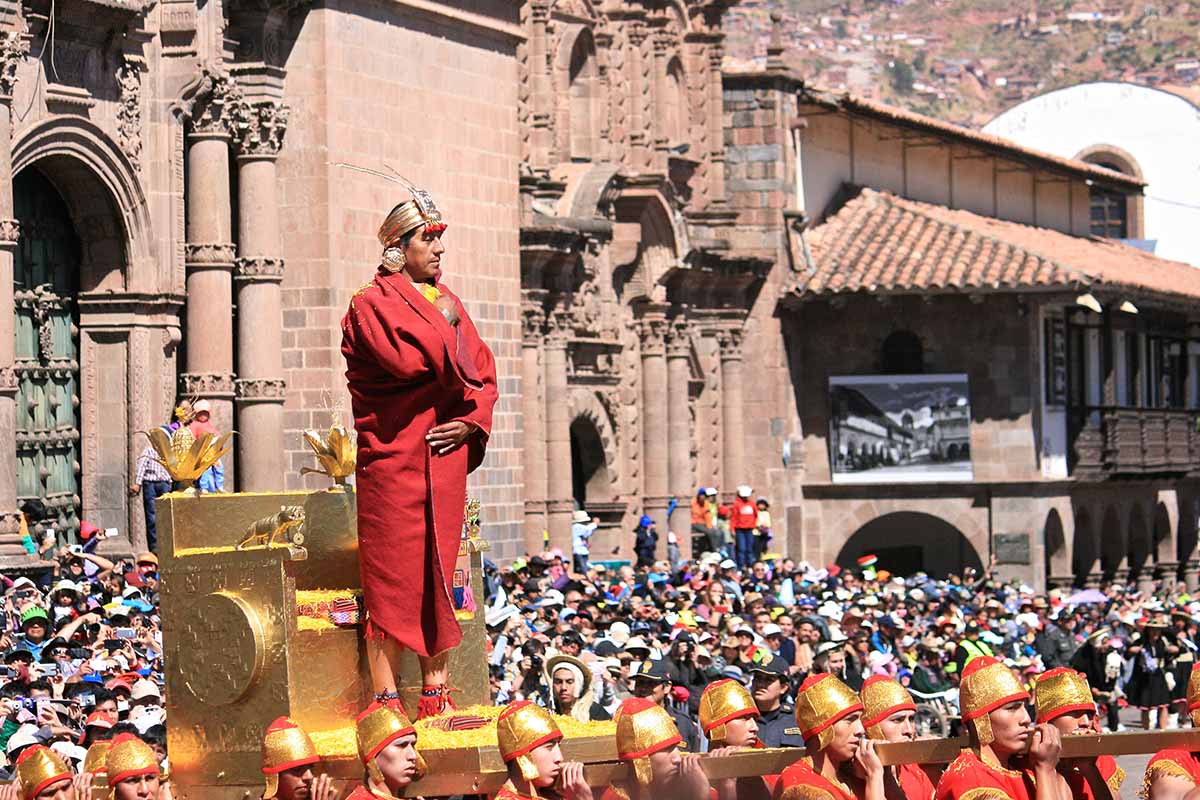
Inti Raymi in Cusco. Photo by Britt Fracolli of Peru for Less.
The word huayno, stemming from the Quechua word huayñunakunay meaning “dancing while holding hands”, describes the folk music that originated in the Peruvian Andes. While huayno music is different between regions, most variations include specific instruments and recurring themes. Quenas and sikus, both traditional Andean flutes, combine with folk music and dances to tell stories of their ancestors .
These sounds and stories of the Andean people have combined with other styles over the years, such as rock, with the Peruvian band UCHPA singing in Quechua, and Argentinian band Soda Stereo using the traditional pan flute in their song, “ Cuando pase el temblor ” (When the Earthquake Ends).
Today, artists like Renata Flores Rivera , dubbed the “Queen of Quechua rap” by the New York Times , have created an innovative new music style combining traditional Andean sounds and the Quechua language with the sounds of today’s popular genres like reggaeton and rap.
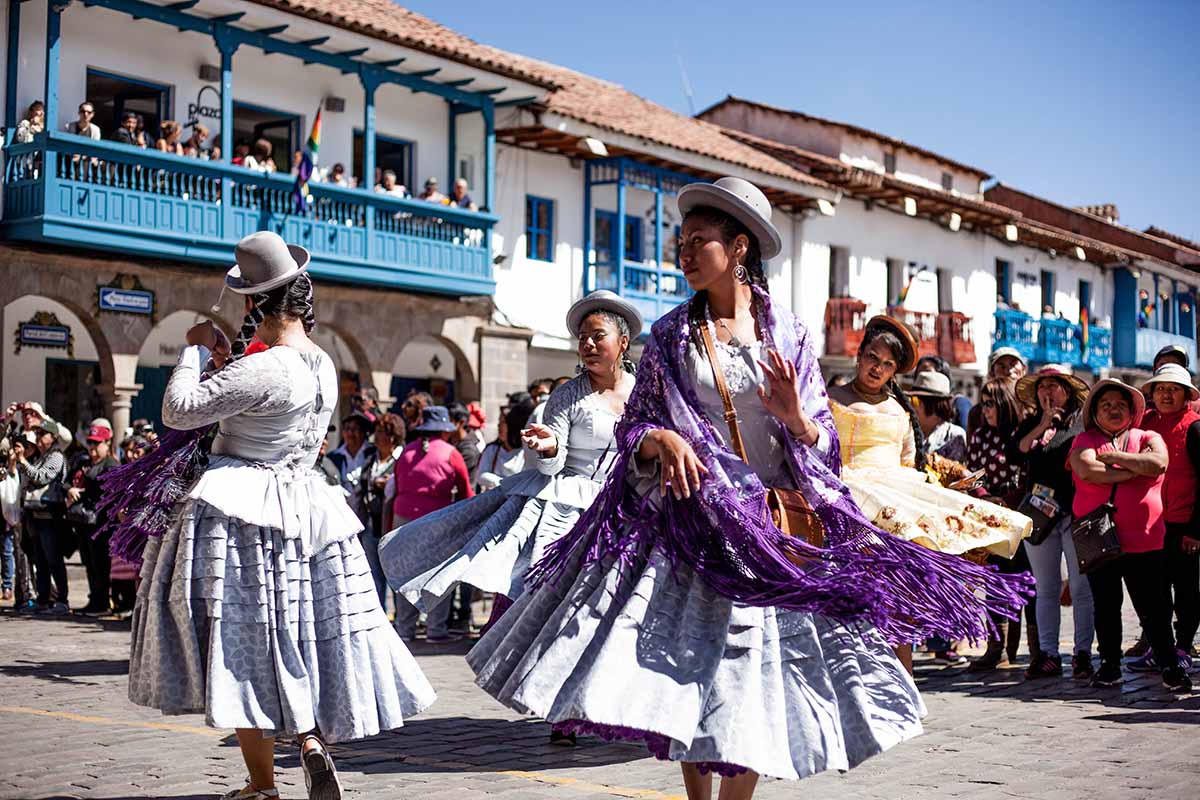
Quechua women dancing. Photo by Peru for Less.
Textiles play an important cultural and economic role for the Andean people. Some communities, such as Chinchero in the Sacred Valley and Taquile on Lake Titicaca , are renowned for the high quality of their textiles. The wool of llamas, alpacas, and sheep is spun, dyed in vibrant colors, and woven into blankets and clothing. Each community uses its own distinct patterns and anthropomorphic designs that have been passed down for generations. Above all, the patterns communicate locally important symbols and myths. Examples of their work can be seen in the thick, multicolored ponchos typically worn by men, the bright skirts and petticoats worn by women, and the chullos, warm hats with ear flaps, seen ubiquitously on the streets and at artisanal markets .
Sacred Valley Tours:
The colorful textiles of the Quechuas and other indigenous groups in Peru are internationally recognized. They have become an integral component in how Peru markets itself as a tourist destination and a great source of revenue for local communities selling to tourists.
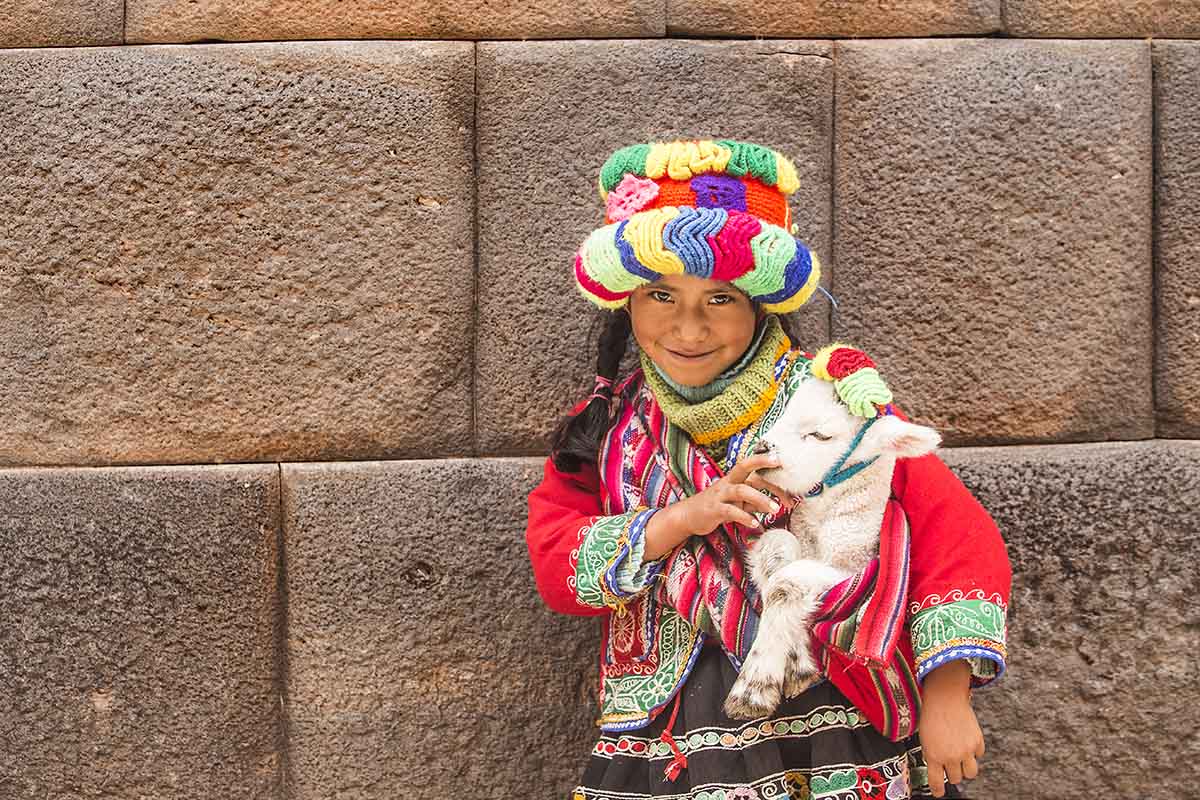
Quechua girl in traditional dress. Photo by Peru for Less.
Runasimi , or “the people’s language”, is the Quechua translation of its language. There is not one single Quechua language today, but rather a family of languages. The Quechua languages that exist today all derived from Proto-Quechua, developed some 2,000 years ago. Today, there are regional varieties of Quechua. The Quechua spoken in Cusco is not the same as the Quechua spoken in Chavín de Huantar or the Quechua (Kichwa) spoken in Ecuador. While there is some overlap, the varieties of Quechua are mutually unintelligible.
Under the Inca Empire, Quechua became the main language used for trade and communication within the Tahuantinsuyu , the four regions of the Empire. Some groups already spoke Quechua, whereas others adopted the language after being incorporated into the empire. The consensus among linguists is that the origins of Quechua are not in Cusco and that the Incas were not responsible for the spread of the language in Peru and across the Andes – with the exception of Bolivia and northern Argentina.
Today, there are an estimated 10-11 million speakers of Quechua between Peru, Bolivia, Ecuador, Chile, and Argentina. Peru has approximately 5.1 million of those speakers per the most recent census in 2017. The Quechua language family is the most widely spoken native language of Peru today.
In South America, the Spanish and Quechua languages have a long history together. For example, some common Quechua words adopted into Spanish include: choclo (corn), cuy (guinea pig), papa (potato), and zapallo (pumpkin). Additionally, some Quechua words have even made it into English: condor, jerky (charqui), llama, pisco, puma, quinine, quinoa, and soroche.
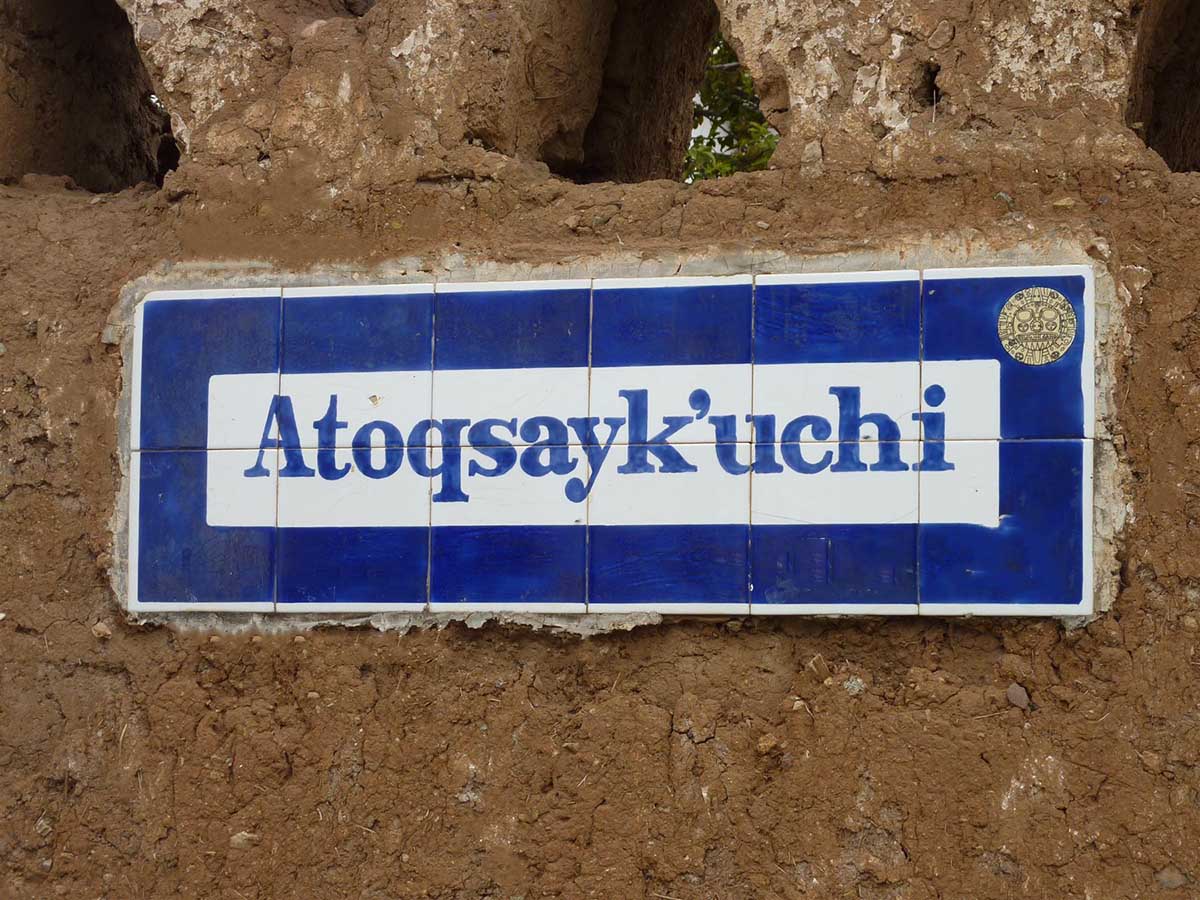
Cusco street sign. Photo by Cédric Liénart on Flickr.
Peru has been named the World’s Leading Culinary Destination every year since the award’s inception in 2012. Home to several superfoods and 3,800 different types of native potatoes , the unique cuisine in Peru has been greatly influenced by the Quechua people and their culinary traditions. For instance, Peruvian people continue to drink coca tea, eat cuy (guinea pig) and alpaca meat, and occasionally cook in the traditional Pachamanca or “earth oven” style.
Located next to the circular terraces of Moray in the Sacred Valley , a new interpretation of high altitude Andean cuisine can be found at Mil . World renowned chef Virgilio Martinez of Lima’s Central created Mil to highlight the local ingredients grown in the Peruvian Andes. This unique restaurant allows guests to discover the cuisine and knowledge from two neighboring Quechua communities.
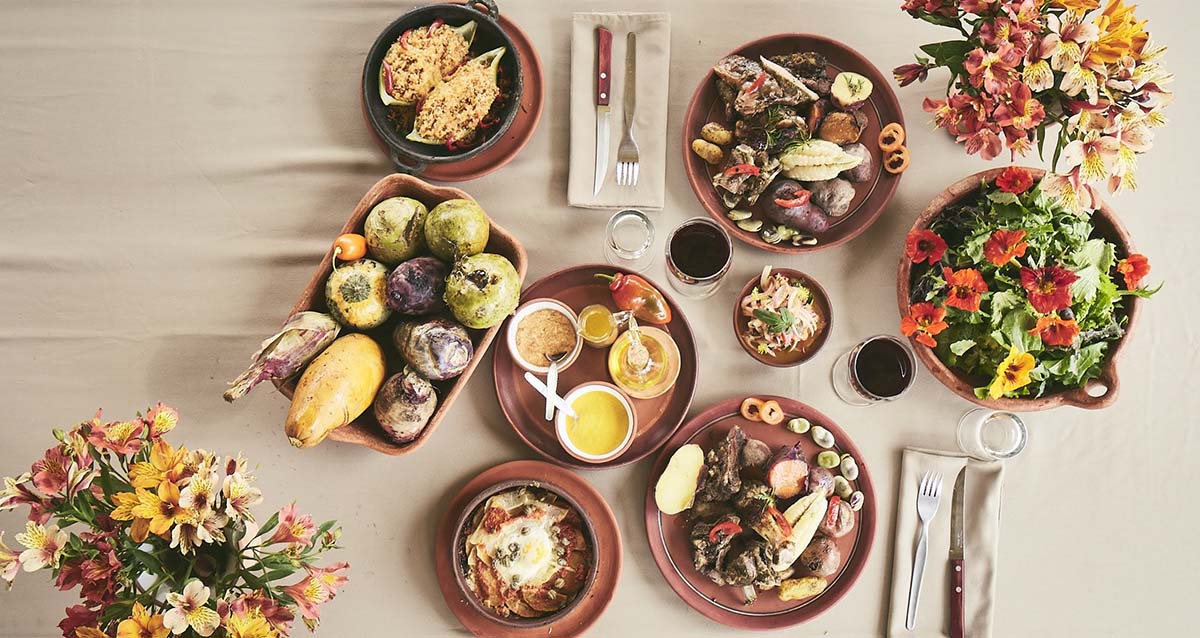
Pachamanca. Photo by El Albergue.
The Quechua people today are not a single ethnic group, but rather several indigenous groups scattered throughout South America, such as the Q’ero and the Wankas in Peru, the Kichwas and Otavalos in Ecuador , the Ingas in Colombia, and the Kallawaya in Bolivia. As a result, there is no longer a sense of a unified “Quechua nation”. However, an incredibly rich set of living Andean traditions coexist (easily and uneasily) with the dominant cultures.
In the 21st century, the history and culture of the Quechua and other indigenous groups became sources of national pride. Quechua is now a co-official language of Peru, Bolivia, and Ecuador. In some Andean regions, bilingual schools offer instruction in Quechua. Festivals like Inti Raymi in Cusco , conducted from start to finish in the Quechua language, are major attractions that showcase indigenous heritage in front of large national and international audiences.
Interested in seeing these lasting traditions of the Quechua people for yourself? Get in touch with our team of expert travel advisors to begin planning your dream trip to Peru .



Email: [email protected]
Sign up to receive our newsletter for great articles, stunning photos, and special deals.